Literature Review: Marketing Communication Mix & Customer Choice
VerifiedAdded on 2023/04/20
|17
|4170
|91
Literature Review
AI Summary
This literature review investigates the impact of the marketing communication mix on customer buying decisions, drawing upon various published journal articles and books. It highlights the importance of marketing strategies in creating product awareness and influencing consumer behavior in a competitive retail market. The review covers key concepts such as customer buying decisions, consumer behavior, and the marketing concept, including the 4Ps (Product, Price, Place, Promotion) and expanded 8Ps. It examines different communication tools like advertising, sales promotion, sponsorship, public relations, interactive marketing, word-of-mouth, and personal selling, emphasizing their roles in shaping customer preferences. The review also references a case study of Giant hypermarket in Asia, showcasing the practical application of these marketing communication strategies.
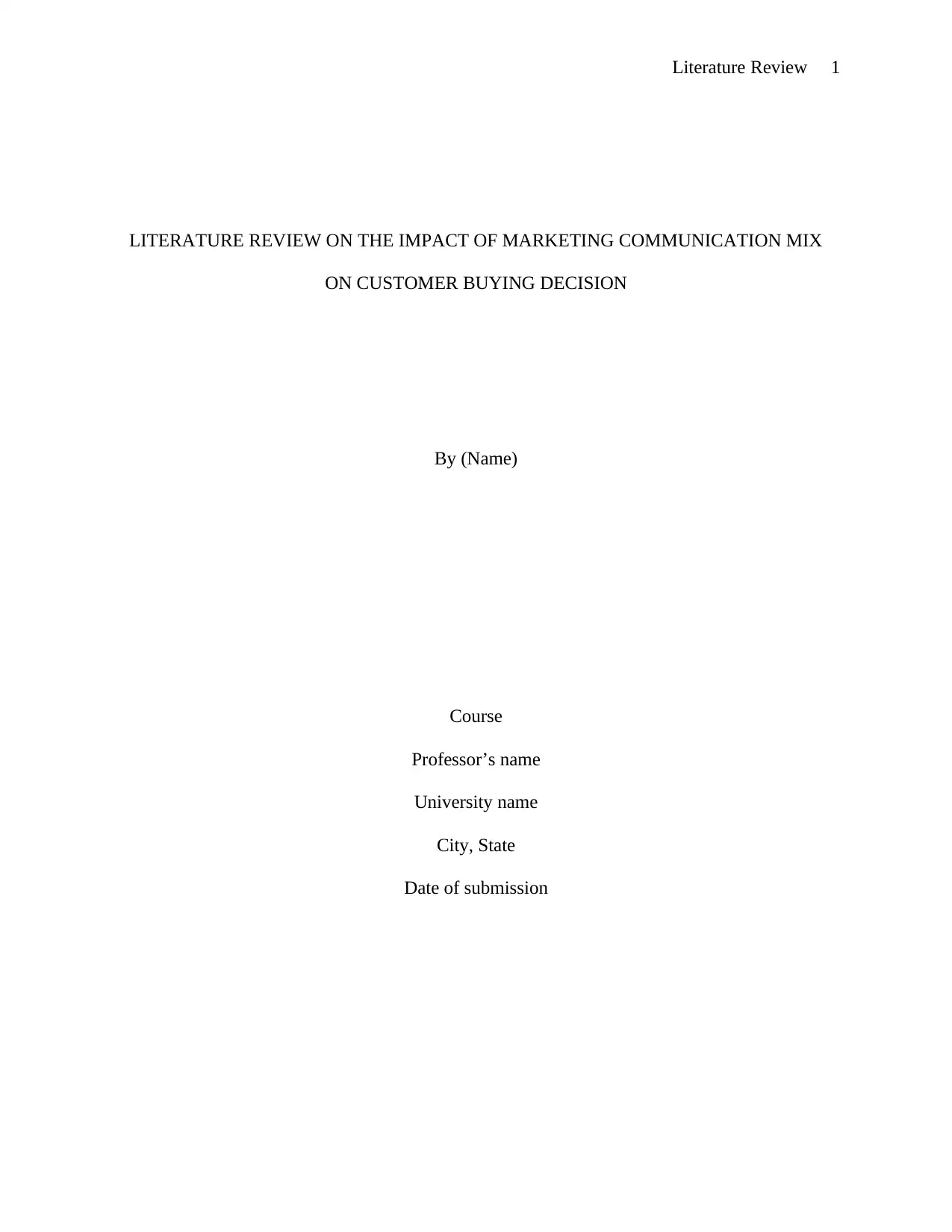
Literature Review 1
LITERATURE REVIEW ON THE IMPACT OF MARKETING COMMUNICATION MIX
ON CUSTOMER BUYING DECISION
By (Name)
Course
Professor’s name
University name
City, State
Date of submission
LITERATURE REVIEW ON THE IMPACT OF MARKETING COMMUNICATION MIX
ON CUSTOMER BUYING DECISION
By (Name)
Course
Professor’s name
University name
City, State
Date of submission
Paraphrase This Document
Need a fresh take? Get an instant paraphrase of this document with our AI Paraphraser
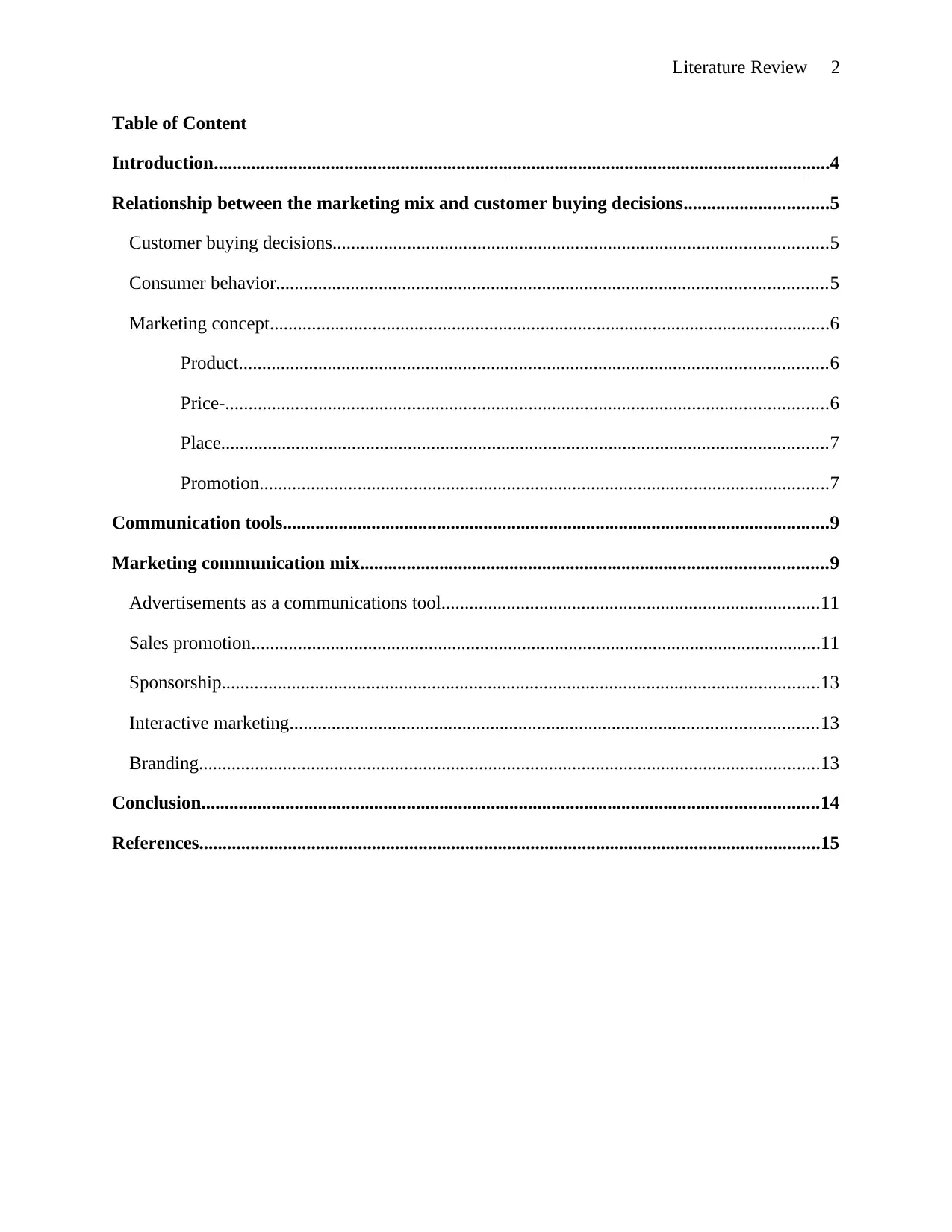
Literature Review 2
Table of Content
Introduction....................................................................................................................................4
Relationship between the marketing mix and customer buying decisions...............................5
Customer buying decisions..........................................................................................................5
Consumer behavior......................................................................................................................5
Marketing concept........................................................................................................................6
Product..............................................................................................................................6
Price-.................................................................................................................................6
Place..................................................................................................................................7
Promotion..........................................................................................................................7
Communication tools.....................................................................................................................9
Marketing communication mix....................................................................................................9
Advertisements as a communications tool.................................................................................11
Sales promotion..........................................................................................................................11
Sponsorship................................................................................................................................13
Interactive marketing.................................................................................................................13
Branding.....................................................................................................................................13
Conclusion....................................................................................................................................14
References.....................................................................................................................................15
Table of Content
Introduction....................................................................................................................................4
Relationship between the marketing mix and customer buying decisions...............................5
Customer buying decisions..........................................................................................................5
Consumer behavior......................................................................................................................5
Marketing concept........................................................................................................................6
Product..............................................................................................................................6
Price-.................................................................................................................................6
Place..................................................................................................................................7
Promotion..........................................................................................................................7
Communication tools.....................................................................................................................9
Marketing communication mix....................................................................................................9
Advertisements as a communications tool.................................................................................11
Sales promotion..........................................................................................................................11
Sponsorship................................................................................................................................13
Interactive marketing.................................................................................................................13
Branding.....................................................................................................................................13
Conclusion....................................................................................................................................14
References.....................................................................................................................................15
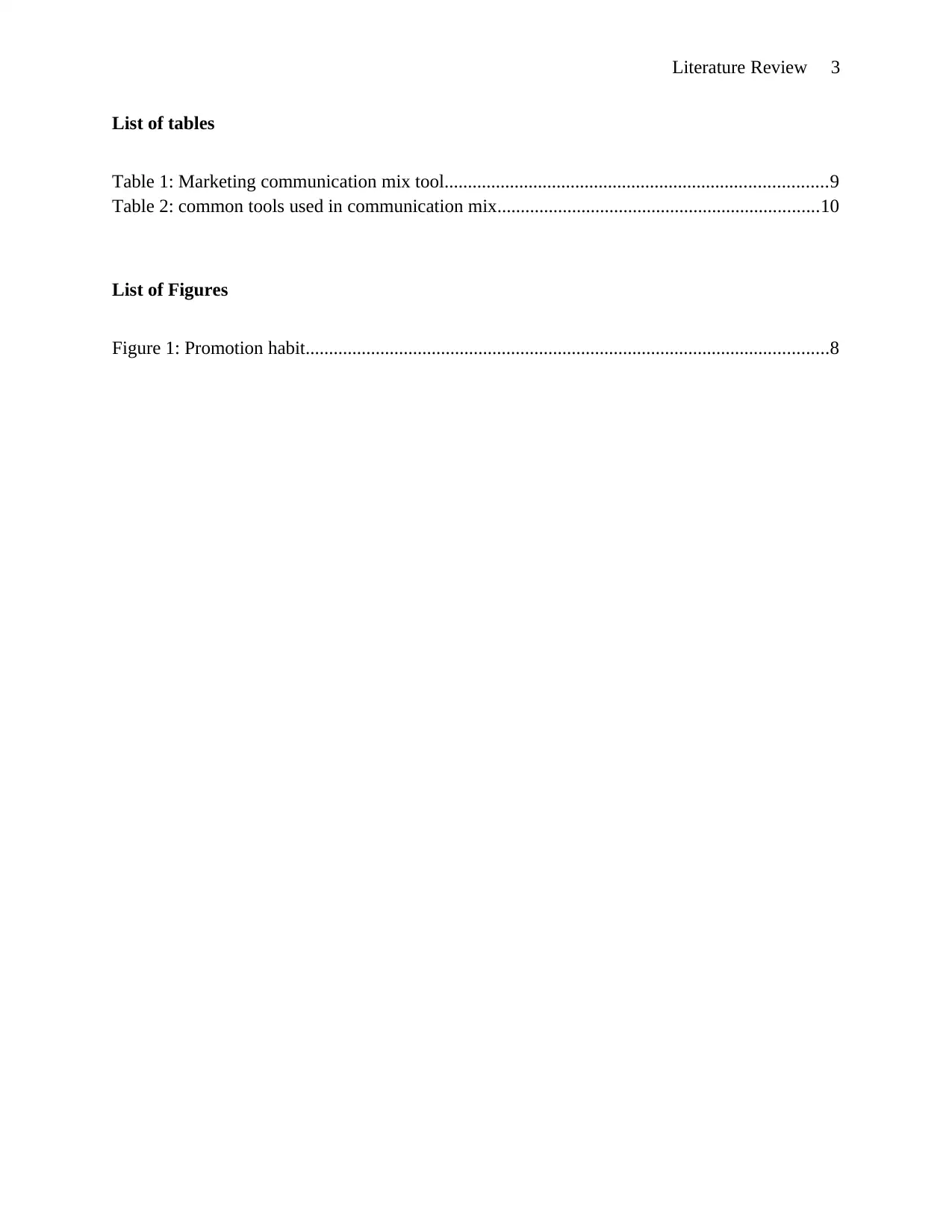
Literature Review 3
List of tables
Table 1: Marketing communication mix tool..................................................................................9
Table 2: common tools used in communication mix.....................................................................10
List of Figures
Figure 1: Promotion habit................................................................................................................8
List of tables
Table 1: Marketing communication mix tool..................................................................................9
Table 2: common tools used in communication mix.....................................................................10
List of Figures
Figure 1: Promotion habit................................................................................................................8
⊘ This is a preview!⊘
Do you want full access?
Subscribe today to unlock all pages.

Trusted by 1+ million students worldwide
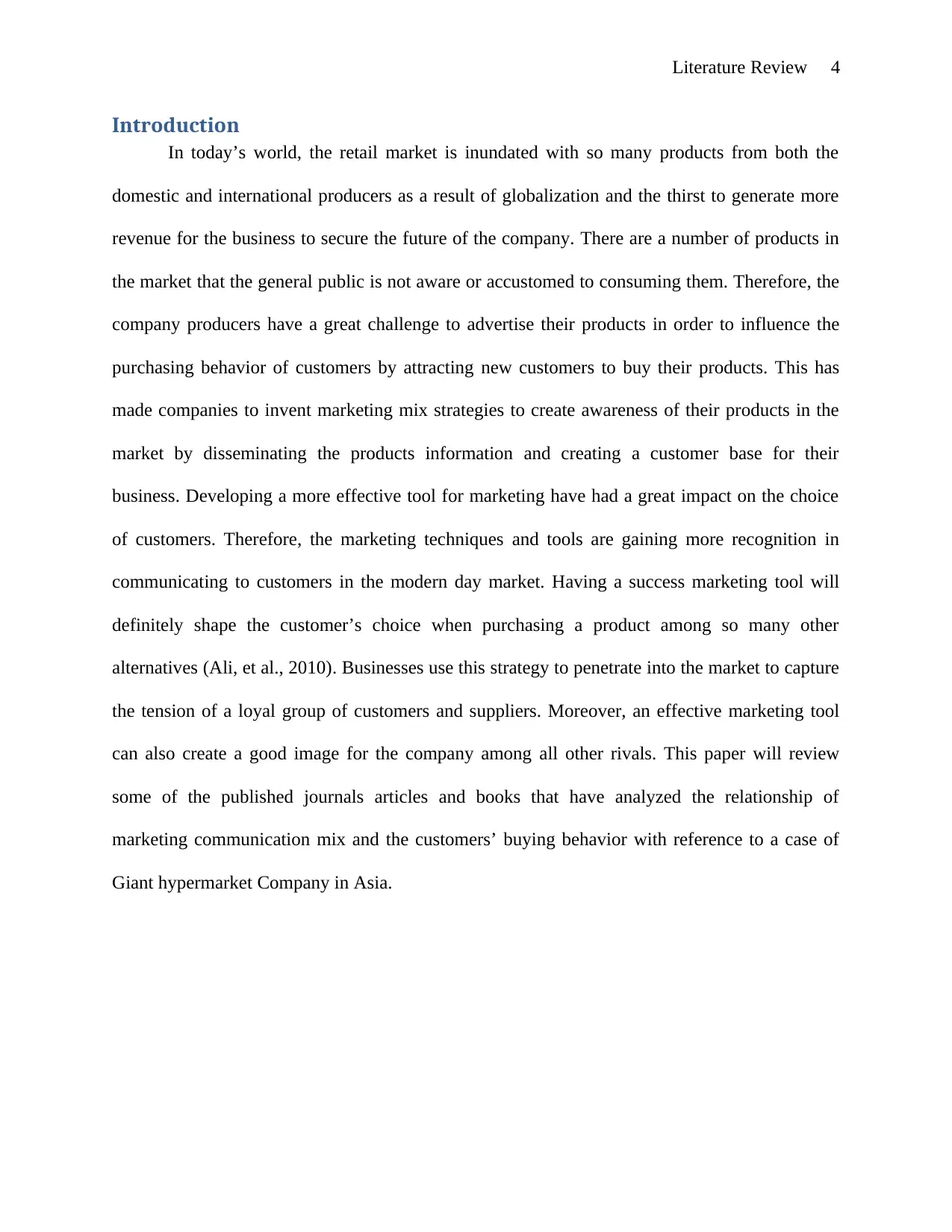
Literature Review 4
Introduction
In today’s world, the retail market is inundated with so many products from both the
domestic and international producers as a result of globalization and the thirst to generate more
revenue for the business to secure the future of the company. There are a number of products in
the market that the general public is not aware or accustomed to consuming them. Therefore, the
company producers have a great challenge to advertise their products in order to influence the
purchasing behavior of customers by attracting new customers to buy their products. This has
made companies to invent marketing mix strategies to create awareness of their products in the
market by disseminating the products information and creating a customer base for their
business. Developing a more effective tool for marketing have had a great impact on the choice
of customers. Therefore, the marketing techniques and tools are gaining more recognition in
communicating to customers in the modern day market. Having a success marketing tool will
definitely shape the customer’s choice when purchasing a product among so many other
alternatives (Ali, et al., 2010). Businesses use this strategy to penetrate into the market to capture
the tension of a loyal group of customers and suppliers. Moreover, an effective marketing tool
can also create a good image for the company among all other rivals. This paper will review
some of the published journals articles and books that have analyzed the relationship of
marketing communication mix and the customers’ buying behavior with reference to a case of
Giant hypermarket Company in Asia.
Introduction
In today’s world, the retail market is inundated with so many products from both the
domestic and international producers as a result of globalization and the thirst to generate more
revenue for the business to secure the future of the company. There are a number of products in
the market that the general public is not aware or accustomed to consuming them. Therefore, the
company producers have a great challenge to advertise their products in order to influence the
purchasing behavior of customers by attracting new customers to buy their products. This has
made companies to invent marketing mix strategies to create awareness of their products in the
market by disseminating the products information and creating a customer base for their
business. Developing a more effective tool for marketing have had a great impact on the choice
of customers. Therefore, the marketing techniques and tools are gaining more recognition in
communicating to customers in the modern day market. Having a success marketing tool will
definitely shape the customer’s choice when purchasing a product among so many other
alternatives (Ali, et al., 2010). Businesses use this strategy to penetrate into the market to capture
the tension of a loyal group of customers and suppliers. Moreover, an effective marketing tool
can also create a good image for the company among all other rivals. This paper will review
some of the published journals articles and books that have analyzed the relationship of
marketing communication mix and the customers’ buying behavior with reference to a case of
Giant hypermarket Company in Asia.
Paraphrase This Document
Need a fresh take? Get an instant paraphrase of this document with our AI Paraphraser
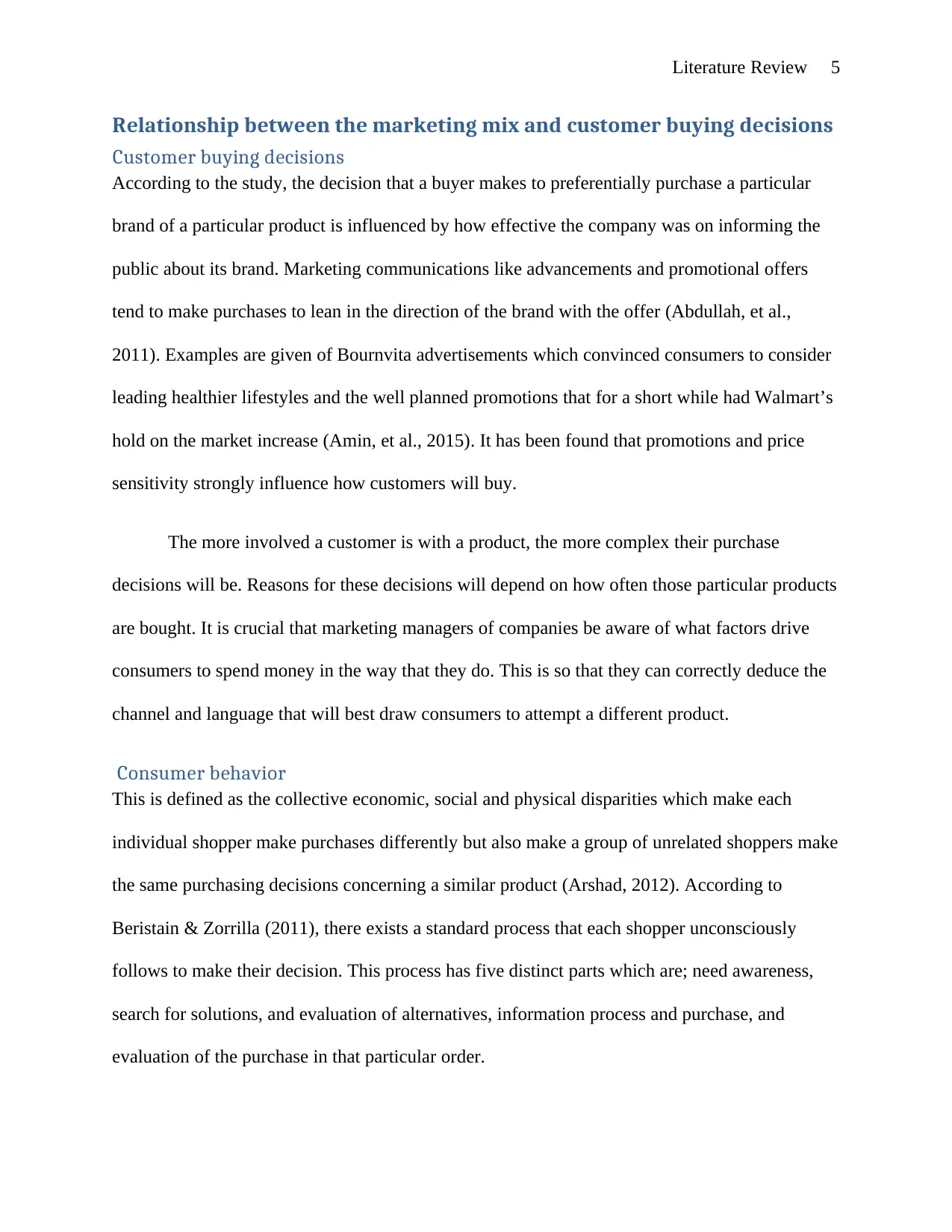
Literature Review 5
Relationship between the marketing mix and customer buying decisions
Customer buying decisions
According to the study, the decision that a buyer makes to preferentially purchase a particular
brand of a particular product is influenced by how effective the company was on informing the
public about its brand. Marketing communications like advancements and promotional offers
tend to make purchases to lean in the direction of the brand with the offer (Abdullah, et al.,
2011). Examples are given of Bournvita advertisements which convinced consumers to consider
leading healthier lifestyles and the well planned promotions that for a short while had Walmart’s
hold on the market increase (Amin, et al., 2015). It has been found that promotions and price
sensitivity strongly influence how customers will buy.
The more involved a customer is with a product, the more complex their purchase
decisions will be. Reasons for these decisions will depend on how often those particular products
are bought. It is crucial that marketing managers of companies be aware of what factors drive
consumers to spend money in the way that they do. This is so that they can correctly deduce the
channel and language that will best draw consumers to attempt a different product.
Consumer behavior
This is defined as the collective economic, social and physical disparities which make each
individual shopper make purchases differently but also make a group of unrelated shoppers make
the same purchasing decisions concerning a similar product (Arshad, 2012). According to
Beristain & Zorrilla (2011), there exists a standard process that each shopper unconsciously
follows to make their decision. This process has five distinct parts which are; need awareness,
search for solutions, and evaluation of alternatives, information process and purchase, and
evaluation of the purchase in that particular order.
Relationship between the marketing mix and customer buying decisions
Customer buying decisions
According to the study, the decision that a buyer makes to preferentially purchase a particular
brand of a particular product is influenced by how effective the company was on informing the
public about its brand. Marketing communications like advancements and promotional offers
tend to make purchases to lean in the direction of the brand with the offer (Abdullah, et al.,
2011). Examples are given of Bournvita advertisements which convinced consumers to consider
leading healthier lifestyles and the well planned promotions that for a short while had Walmart’s
hold on the market increase (Amin, et al., 2015). It has been found that promotions and price
sensitivity strongly influence how customers will buy.
The more involved a customer is with a product, the more complex their purchase
decisions will be. Reasons for these decisions will depend on how often those particular products
are bought. It is crucial that marketing managers of companies be aware of what factors drive
consumers to spend money in the way that they do. This is so that they can correctly deduce the
channel and language that will best draw consumers to attempt a different product.
Consumer behavior
This is defined as the collective economic, social and physical disparities which make each
individual shopper make purchases differently but also make a group of unrelated shoppers make
the same purchasing decisions concerning a similar product (Arshad, 2012). According to
Beristain & Zorrilla (2011), there exists a standard process that each shopper unconsciously
follows to make their decision. This process has five distinct parts which are; need awareness,
search for solutions, and evaluation of alternatives, information process and purchase, and
evaluation of the purchase in that particular order.
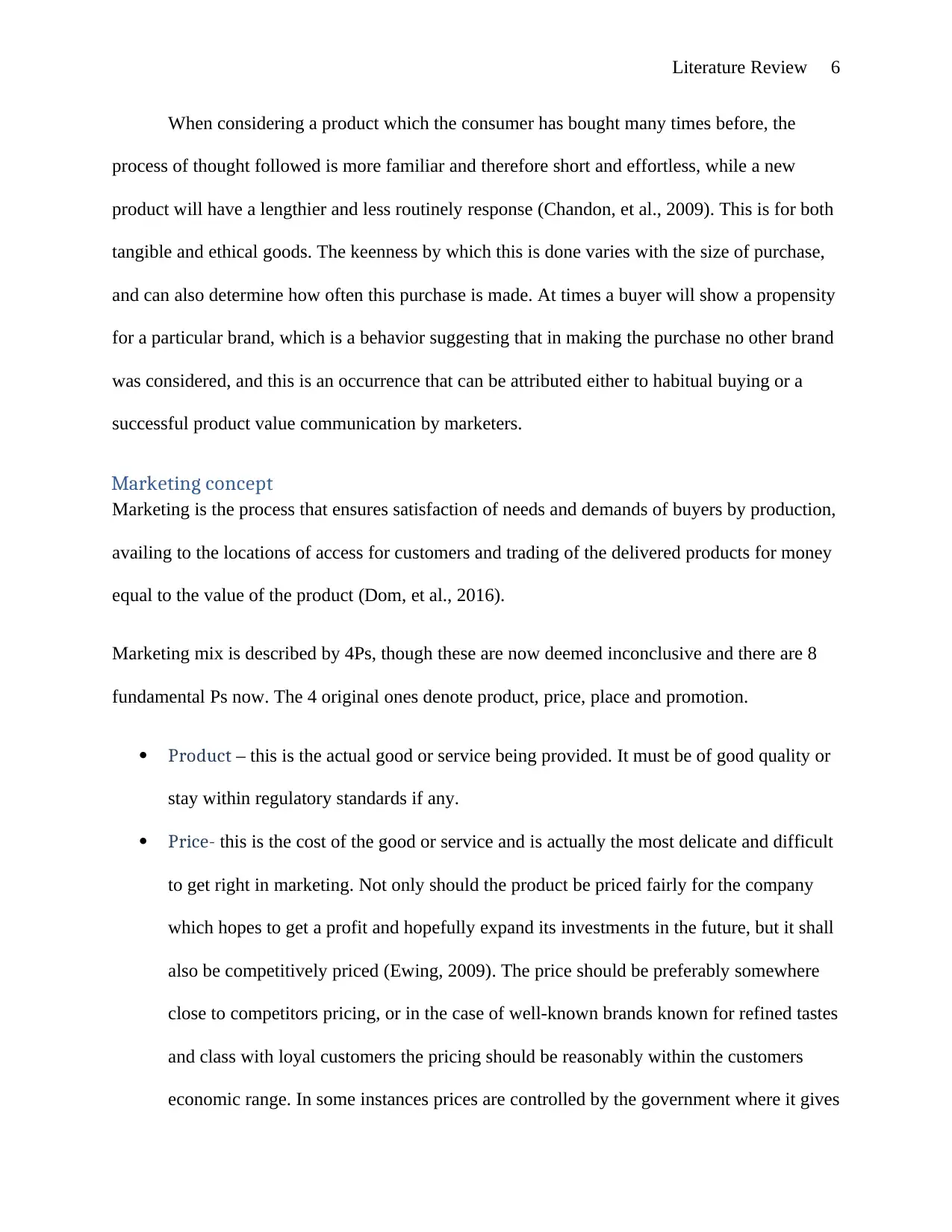
Literature Review 6
When considering a product which the consumer has bought many times before, the
process of thought followed is more familiar and therefore short and effortless, while a new
product will have a lengthier and less routinely response (Chandon, et al., 2009). This is for both
tangible and ethical goods. The keenness by which this is done varies with the size of purchase,
and can also determine how often this purchase is made. At times a buyer will show a propensity
for a particular brand, which is a behavior suggesting that in making the purchase no other brand
was considered, and this is an occurrence that can be attributed either to habitual buying or a
successful product value communication by marketers.
Marketing concept
Marketing is the process that ensures satisfaction of needs and demands of buyers by production,
availing to the locations of access for customers and trading of the delivered products for money
equal to the value of the product (Dom, et al., 2016).
Marketing mix is described by 4Ps, though these are now deemed inconclusive and there are 8
fundamental Ps now. The 4 original ones denote product, price, place and promotion.
Product – this is the actual good or service being provided. It must be of good quality or
stay within regulatory standards if any.
Price- this is the cost of the good or service and is actually the most delicate and difficult
to get right in marketing. Not only should the product be priced fairly for the company
which hopes to get a profit and hopefully expand its investments in the future, but it shall
also be competitively priced (Ewing, 2009). The price should be preferably somewhere
close to competitors pricing, or in the case of well-known brands known for refined tastes
and class with loyal customers the pricing should be reasonably within the customers
economic range. In some instances prices are controlled by the government where it gives
When considering a product which the consumer has bought many times before, the
process of thought followed is more familiar and therefore short and effortless, while a new
product will have a lengthier and less routinely response (Chandon, et al., 2009). This is for both
tangible and ethical goods. The keenness by which this is done varies with the size of purchase,
and can also determine how often this purchase is made. At times a buyer will show a propensity
for a particular brand, which is a behavior suggesting that in making the purchase no other brand
was considered, and this is an occurrence that can be attributed either to habitual buying or a
successful product value communication by marketers.
Marketing concept
Marketing is the process that ensures satisfaction of needs and demands of buyers by production,
availing to the locations of access for customers and trading of the delivered products for money
equal to the value of the product (Dom, et al., 2016).
Marketing mix is described by 4Ps, though these are now deemed inconclusive and there are 8
fundamental Ps now. The 4 original ones denote product, price, place and promotion.
Product – this is the actual good or service being provided. It must be of good quality or
stay within regulatory standards if any.
Price- this is the cost of the good or service and is actually the most delicate and difficult
to get right in marketing. Not only should the product be priced fairly for the company
which hopes to get a profit and hopefully expand its investments in the future, but it shall
also be competitively priced (Ewing, 2009). The price should be preferably somewhere
close to competitors pricing, or in the case of well-known brands known for refined tastes
and class with loyal customers the pricing should be reasonably within the customers
economic range. In some instances prices are controlled by the government where it gives
⊘ This is a preview!⊘
Do you want full access?
Subscribe today to unlock all pages.

Trusted by 1+ million students worldwide

Literature Review 7
a carpet and a ceiling for the price. This is a government regulation and must be taken
into account (Hoyer & MacInnis, 2010). Most importantly, though, the pricing should be
a reflection of the true value of the product and be stable not to oscillate.
Place- this denotes the target market as well as the means by which the product shall get
to the market. Incoming advancements in technology have made it possible for the target
market and the company to virtually meet online and carry out trade without actually
having to be in a room together or within a close distance to each other.
Promotion – is the information concerning a particular product that is availed by
marketers of a company that assists the buyer in making purchasing decisions. For a
product to be essentially sold, it is not enough to manufacture it, assign a cost to it, and
ensure it makes it to the shop. It must be backed up by providing necessary information
about the product to both present and prospective customers, wholesalers and retailers,
and stakeholders (Julian, et al., 2016). For this reason a target market segment will be
more effectively accessed by an effective marketing communication mix. This is a tool
that not only gets the goods and services known but also promotes a positive image of the
brand in the minds of customers. This concept has been adopted by Giant hypermarket to
influence customer’s choice.
a carpet and a ceiling for the price. This is a government regulation and must be taken
into account (Hoyer & MacInnis, 2010). Most importantly, though, the pricing should be
a reflection of the true value of the product and be stable not to oscillate.
Place- this denotes the target market as well as the means by which the product shall get
to the market. Incoming advancements in technology have made it possible for the target
market and the company to virtually meet online and carry out trade without actually
having to be in a room together or within a close distance to each other.
Promotion – is the information concerning a particular product that is availed by
marketers of a company that assists the buyer in making purchasing decisions. For a
product to be essentially sold, it is not enough to manufacture it, assign a cost to it, and
ensure it makes it to the shop. It must be backed up by providing necessary information
about the product to both present and prospective customers, wholesalers and retailers,
and stakeholders (Julian, et al., 2016). For this reason a target market segment will be
more effectively accessed by an effective marketing communication mix. This is a tool
that not only gets the goods and services known but also promotes a positive image of the
brand in the minds of customers. This concept has been adopted by Giant hypermarket to
influence customer’s choice.
Paraphrase This Document
Need a fresh take? Get an instant paraphrase of this document with our AI Paraphraser
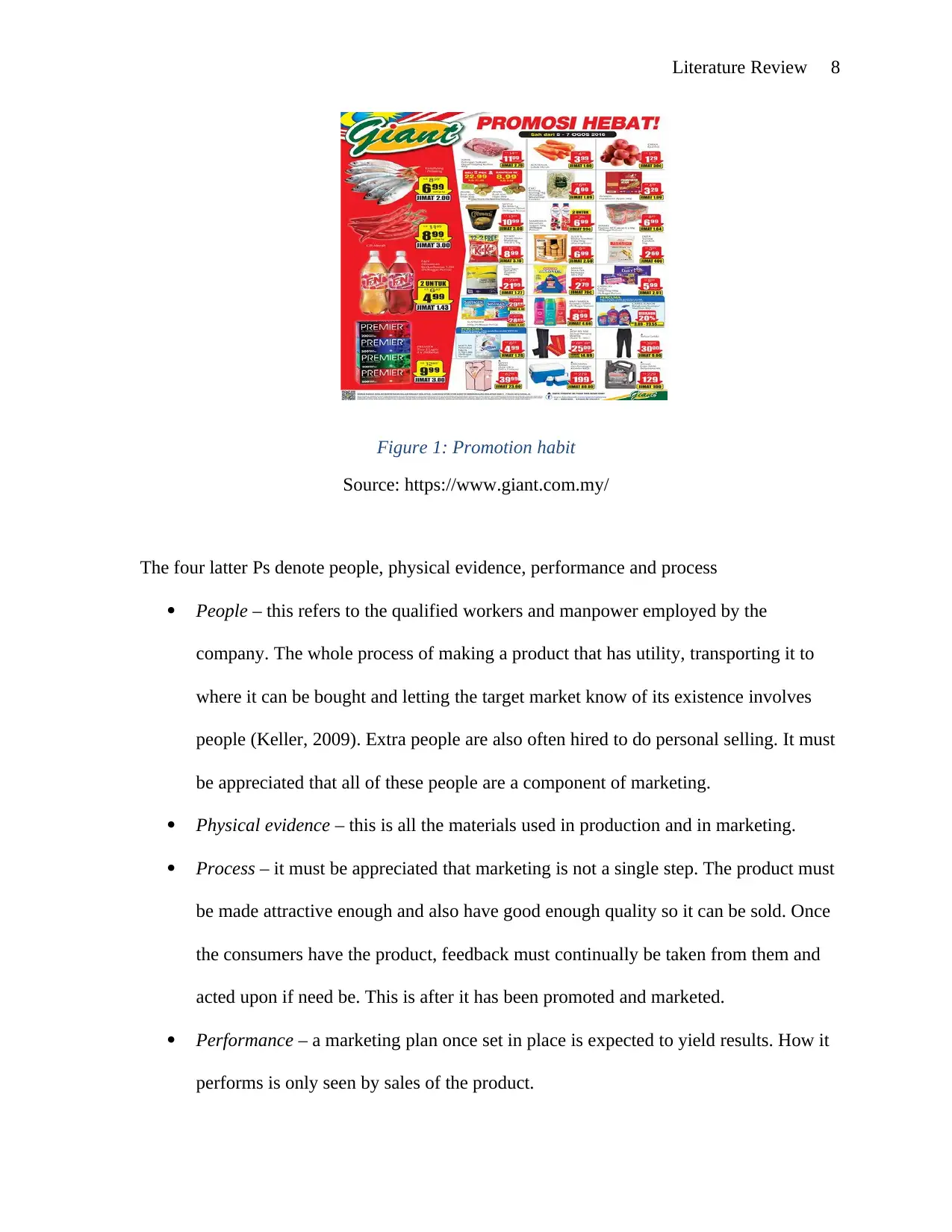
Literature Review 8
Figure 1: Promotion habit
Source: https://www.giant.com.my/
The four latter Ps denote people, physical evidence, performance and process
People – this refers to the qualified workers and manpower employed by the
company. The whole process of making a product that has utility, transporting it to
where it can be bought and letting the target market know of its existence involves
people (Keller, 2009). Extra people are also often hired to do personal selling. It must
be appreciated that all of these people are a component of marketing.
Physical evidence – this is all the materials used in production and in marketing.
Process – it must be appreciated that marketing is not a single step. The product must
be made attractive enough and also have good enough quality so it can be sold. Once
the consumers have the product, feedback must continually be taken from them and
acted upon if need be. This is after it has been promoted and marketed.
Performance – a marketing plan once set in place is expected to yield results. How it
performs is only seen by sales of the product.
Figure 1: Promotion habit
Source: https://www.giant.com.my/
The four latter Ps denote people, physical evidence, performance and process
People – this refers to the qualified workers and manpower employed by the
company. The whole process of making a product that has utility, transporting it to
where it can be bought and letting the target market know of its existence involves
people (Keller, 2009). Extra people are also often hired to do personal selling. It must
be appreciated that all of these people are a component of marketing.
Physical evidence – this is all the materials used in production and in marketing.
Process – it must be appreciated that marketing is not a single step. The product must
be made attractive enough and also have good enough quality so it can be sold. Once
the consumers have the product, feedback must continually be taken from them and
acted upon if need be. This is after it has been promoted and marketed.
Performance – a marketing plan once set in place is expected to yield results. How it
performs is only seen by sales of the product.
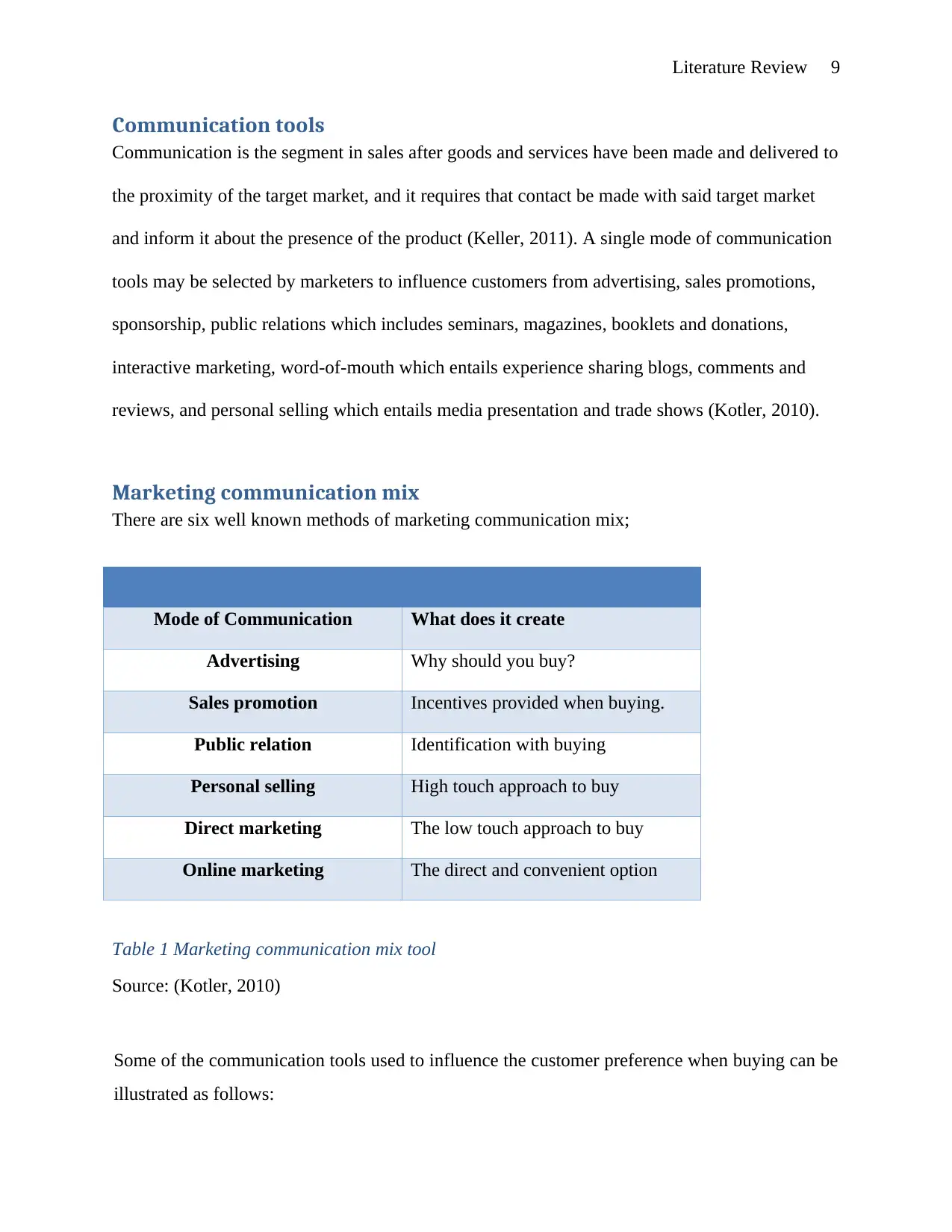
Literature Review 9
Communication tools
Communication is the segment in sales after goods and services have been made and delivered to
the proximity of the target market, and it requires that contact be made with said target market
and inform it about the presence of the product (Keller, 2011). A single mode of communication
tools may be selected by marketers to influence customers from advertising, sales promotions,
sponsorship, public relations which includes seminars, magazines, booklets and donations,
interactive marketing, word-of-mouth which entails experience sharing blogs, comments and
reviews, and personal selling which entails media presentation and trade shows (Kotler, 2010).
Marketing communication mix
There are six well known methods of marketing communication mix;
Mode of Communication What does it create
Advertising Why should you buy?
Sales promotion Incentives provided when buying.
Public relation Identification with buying
Personal selling High touch approach to buy
Direct marketing The low touch approach to buy
Online marketing The direct and convenient option
Table 1 Marketing communication mix tool
Source: (Kotler, 2010)
Some of the communication tools used to influence the customer preference when buying can be
illustrated as follows:
Communication tools
Communication is the segment in sales after goods and services have been made and delivered to
the proximity of the target market, and it requires that contact be made with said target market
and inform it about the presence of the product (Keller, 2011). A single mode of communication
tools may be selected by marketers to influence customers from advertising, sales promotions,
sponsorship, public relations which includes seminars, magazines, booklets and donations,
interactive marketing, word-of-mouth which entails experience sharing blogs, comments and
reviews, and personal selling which entails media presentation and trade shows (Kotler, 2010).
Marketing communication mix
There are six well known methods of marketing communication mix;
Mode of Communication What does it create
Advertising Why should you buy?
Sales promotion Incentives provided when buying.
Public relation Identification with buying
Personal selling High touch approach to buy
Direct marketing The low touch approach to buy
Online marketing The direct and convenient option
Table 1 Marketing communication mix tool
Source: (Kotler, 2010)
Some of the communication tools used to influence the customer preference when buying can be
illustrated as follows:
⊘ This is a preview!⊘
Do you want full access?
Subscribe today to unlock all pages.

Trusted by 1+ million students worldwide
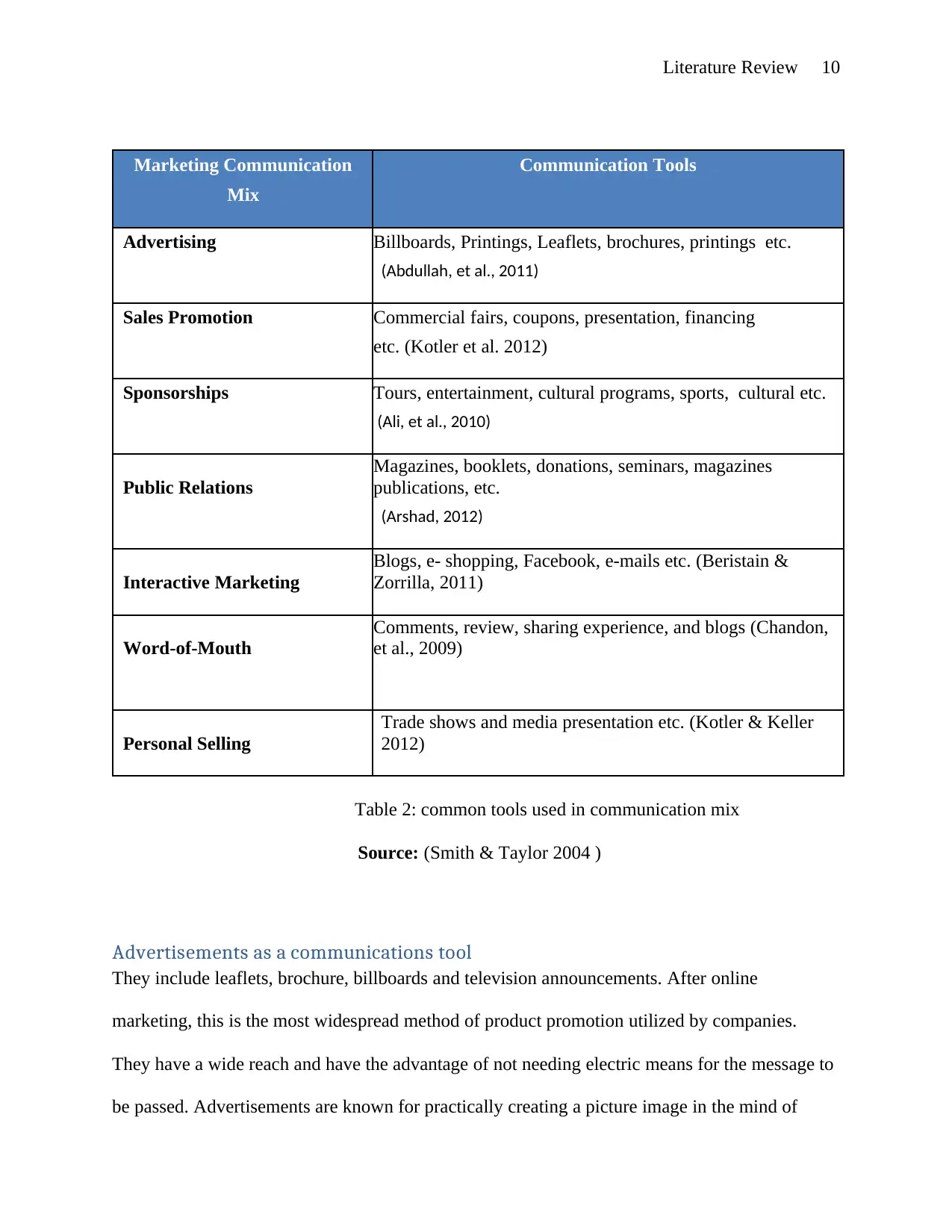
Literature Review 10
Marketing Communication Communication Tools
Mix
Advertising Billboards, Printings, Leaflets, brochures, printings etc.
(Abdullah, et al., 2011)
Sales Promotion Commercial fairs, coupons, presentation, financing
etc. (Kotler et al. 2012)
Sponsorships Tours, entertainment, cultural programs, sports, cultural etc.
(Ali, et al., 2010)
Public Relations
Magazines, booklets, donations, seminars, magazines
publications, etc.
(Arshad, 2012)
Interactive Marketing
Blogs, e- shopping, Facebook, e-mails etc. (Beristain &
Zorrilla, 2011)
Word-of-Mouth
Comments, review, sharing experience, and blogs (Chandon,
et al., 2009)
Personal Selling
Trade shows and media presentation etc. (Kotler & Keller
2012)
Table 2: common tools used in communication mix
Source: (Smith & Taylor 2004 )
Advertisements as a communications tool
They include leaflets, brochure, billboards and television announcements. After online
marketing, this is the most widespread method of product promotion utilized by companies.
They have a wide reach and have the advantage of not needing electric means for the message to
be passed. Advertisements are known for practically creating a picture image in the mind of
Marketing Communication Communication Tools
Mix
Advertising Billboards, Printings, Leaflets, brochures, printings etc.
(Abdullah, et al., 2011)
Sales Promotion Commercial fairs, coupons, presentation, financing
etc. (Kotler et al. 2012)
Sponsorships Tours, entertainment, cultural programs, sports, cultural etc.
(Ali, et al., 2010)
Public Relations
Magazines, booklets, donations, seminars, magazines
publications, etc.
(Arshad, 2012)
Interactive Marketing
Blogs, e- shopping, Facebook, e-mails etc. (Beristain &
Zorrilla, 2011)
Word-of-Mouth
Comments, review, sharing experience, and blogs (Chandon,
et al., 2009)
Personal Selling
Trade shows and media presentation etc. (Kotler & Keller
2012)
Table 2: common tools used in communication mix
Source: (Smith & Taylor 2004 )
Advertisements as a communications tool
They include leaflets, brochure, billboards and television announcements. After online
marketing, this is the most widespread method of product promotion utilized by companies.
They have a wide reach and have the advantage of not needing electric means for the message to
be passed. Advertisements are known for practically creating a picture image in the mind of
Paraphrase This Document
Need a fresh take? Get an instant paraphrase of this document with our AI Paraphraser
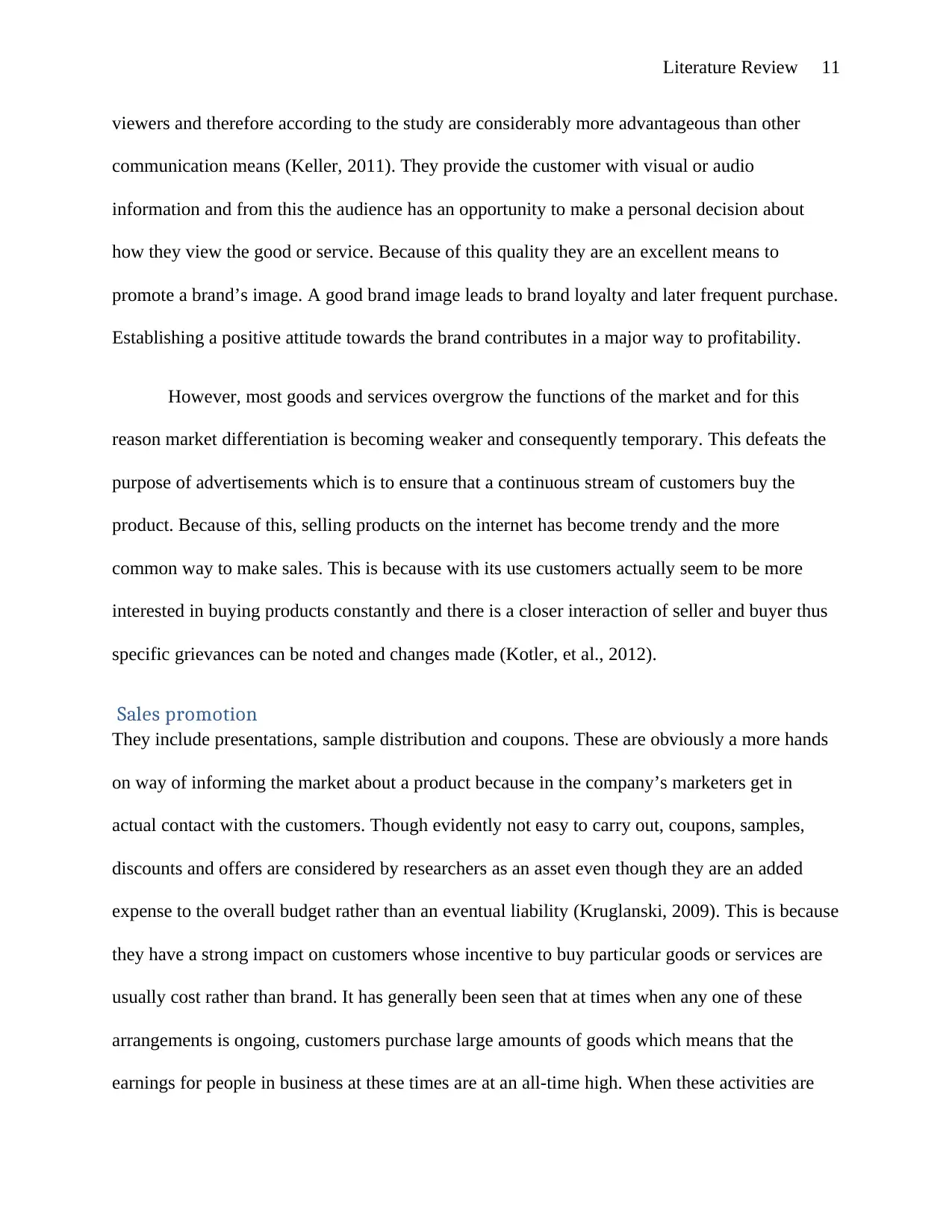
Literature Review 11
viewers and therefore according to the study are considerably more advantageous than other
communication means (Keller, 2011). They provide the customer with visual or audio
information and from this the audience has an opportunity to make a personal decision about
how they view the good or service. Because of this quality they are an excellent means to
promote a brand’s image. A good brand image leads to brand loyalty and later frequent purchase.
Establishing a positive attitude towards the brand contributes in a major way to profitability.
However, most goods and services overgrow the functions of the market and for this
reason market differentiation is becoming weaker and consequently temporary. This defeats the
purpose of advertisements which is to ensure that a continuous stream of customers buy the
product. Because of this, selling products on the internet has become trendy and the more
common way to make sales. This is because with its use customers actually seem to be more
interested in buying products constantly and there is a closer interaction of seller and buyer thus
specific grievances can be noted and changes made (Kotler, et al., 2012).
Sales promotion
They include presentations, sample distribution and coupons. These are obviously a more hands
on way of informing the market about a product because in the company’s marketers get in
actual contact with the customers. Though evidently not easy to carry out, coupons, samples,
discounts and offers are considered by researchers as an asset even though they are an added
expense to the overall budget rather than an eventual liability (Kruglanski, 2009). This is because
they have a strong impact on customers whose incentive to buy particular goods or services are
usually cost rather than brand. It has generally been seen that at times when any one of these
arrangements is ongoing, customers purchase large amounts of goods which means that the
earnings for people in business at these times are at an all-time high. When these activities are
viewers and therefore according to the study are considerably more advantageous than other
communication means (Keller, 2011). They provide the customer with visual or audio
information and from this the audience has an opportunity to make a personal decision about
how they view the good or service. Because of this quality they are an excellent means to
promote a brand’s image. A good brand image leads to brand loyalty and later frequent purchase.
Establishing a positive attitude towards the brand contributes in a major way to profitability.
However, most goods and services overgrow the functions of the market and for this
reason market differentiation is becoming weaker and consequently temporary. This defeats the
purpose of advertisements which is to ensure that a continuous stream of customers buy the
product. Because of this, selling products on the internet has become trendy and the more
common way to make sales. This is because with its use customers actually seem to be more
interested in buying products constantly and there is a closer interaction of seller and buyer thus
specific grievances can be noted and changes made (Kotler, et al., 2012).
Sales promotion
They include presentations, sample distribution and coupons. These are obviously a more hands
on way of informing the market about a product because in the company’s marketers get in
actual contact with the customers. Though evidently not easy to carry out, coupons, samples,
discounts and offers are considered by researchers as an asset even though they are an added
expense to the overall budget rather than an eventual liability (Kruglanski, 2009). This is because
they have a strong impact on customers whose incentive to buy particular goods or services are
usually cost rather than brand. It has generally been seen that at times when any one of these
arrangements is ongoing, customers purchase large amounts of goods which means that the
earnings for people in business at these times are at an all-time high. When these activities are
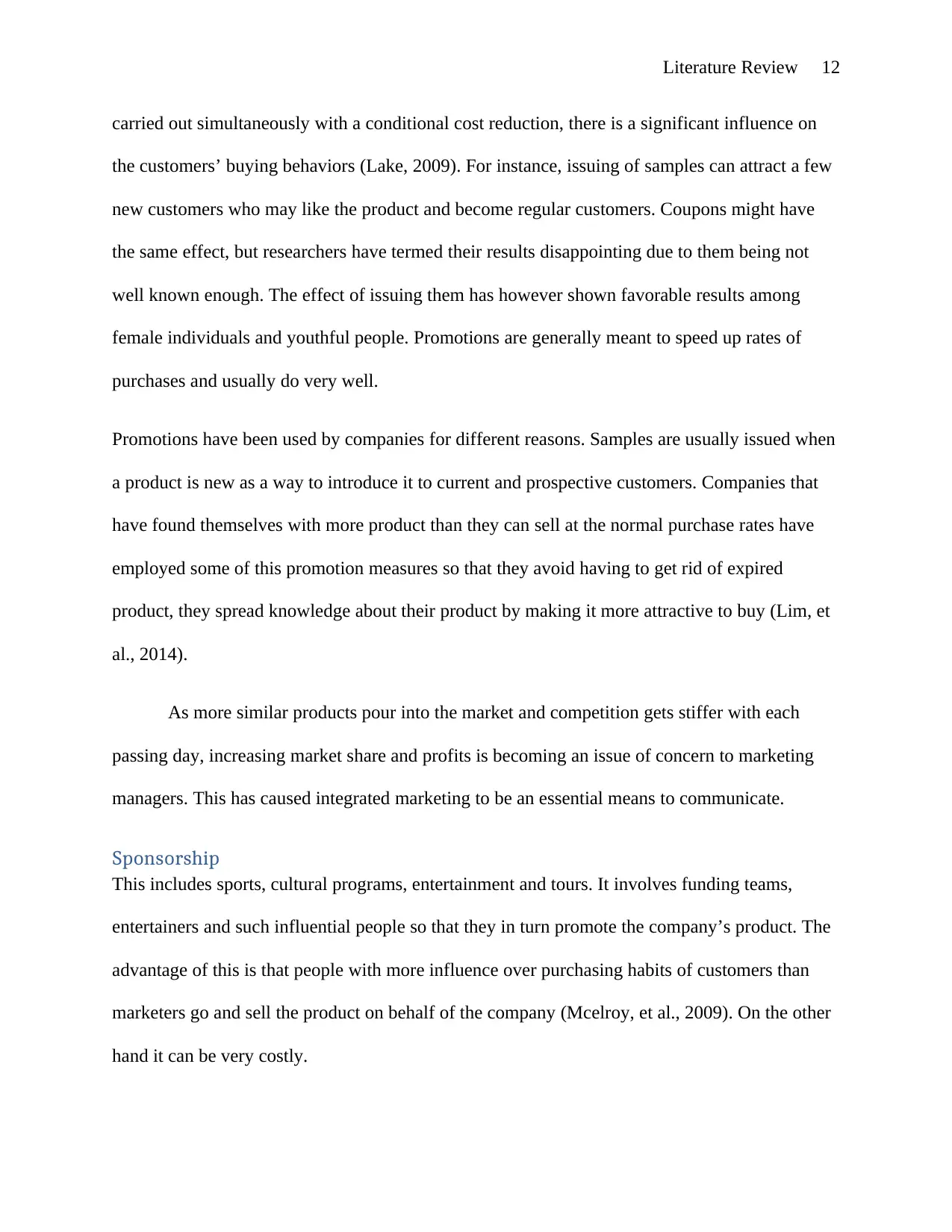
Literature Review 12
carried out simultaneously with a conditional cost reduction, there is a significant influence on
the customers’ buying behaviors (Lake, 2009). For instance, issuing of samples can attract a few
new customers who may like the product and become regular customers. Coupons might have
the same effect, but researchers have termed their results disappointing due to them being not
well known enough. The effect of issuing them has however shown favorable results among
female individuals and youthful people. Promotions are generally meant to speed up rates of
purchases and usually do very well.
Promotions have been used by companies for different reasons. Samples are usually issued when
a product is new as a way to introduce it to current and prospective customers. Companies that
have found themselves with more product than they can sell at the normal purchase rates have
employed some of this promotion measures so that they avoid having to get rid of expired
product, they spread knowledge about their product by making it more attractive to buy (Lim, et
al., 2014).
As more similar products pour into the market and competition gets stiffer with each
passing day, increasing market share and profits is becoming an issue of concern to marketing
managers. This has caused integrated marketing to be an essential means to communicate.
Sponsorship
This includes sports, cultural programs, entertainment and tours. It involves funding teams,
entertainers and such influential people so that they in turn promote the company’s product. The
advantage of this is that people with more influence over purchasing habits of customers than
marketers go and sell the product on behalf of the company (Mcelroy, et al., 2009). On the other
hand it can be very costly.
carried out simultaneously with a conditional cost reduction, there is a significant influence on
the customers’ buying behaviors (Lake, 2009). For instance, issuing of samples can attract a few
new customers who may like the product and become regular customers. Coupons might have
the same effect, but researchers have termed their results disappointing due to them being not
well known enough. The effect of issuing them has however shown favorable results among
female individuals and youthful people. Promotions are generally meant to speed up rates of
purchases and usually do very well.
Promotions have been used by companies for different reasons. Samples are usually issued when
a product is new as a way to introduce it to current and prospective customers. Companies that
have found themselves with more product than they can sell at the normal purchase rates have
employed some of this promotion measures so that they avoid having to get rid of expired
product, they spread knowledge about their product by making it more attractive to buy (Lim, et
al., 2014).
As more similar products pour into the market and competition gets stiffer with each
passing day, increasing market share and profits is becoming an issue of concern to marketing
managers. This has caused integrated marketing to be an essential means to communicate.
Sponsorship
This includes sports, cultural programs, entertainment and tours. It involves funding teams,
entertainers and such influential people so that they in turn promote the company’s product. The
advantage of this is that people with more influence over purchasing habits of customers than
marketers go and sell the product on behalf of the company (Mcelroy, et al., 2009). On the other
hand it can be very costly.
⊘ This is a preview!⊘
Do you want full access?
Subscribe today to unlock all pages.

Trusted by 1+ million students worldwide
1 out of 17
Related Documents
Your All-in-One AI-Powered Toolkit for Academic Success.
+13062052269
info@desklib.com
Available 24*7 on WhatsApp / Email
![[object Object]](/_next/static/media/star-bottom.7253800d.svg)
Unlock your academic potential
Copyright © 2020–2025 A2Z Services. All Rights Reserved. Developed and managed by ZUCOL.




